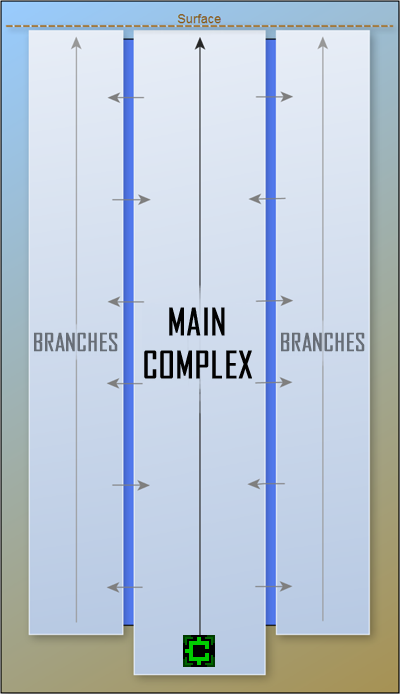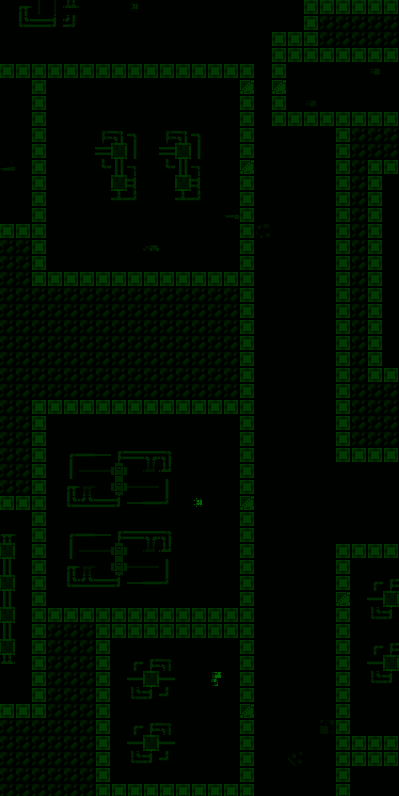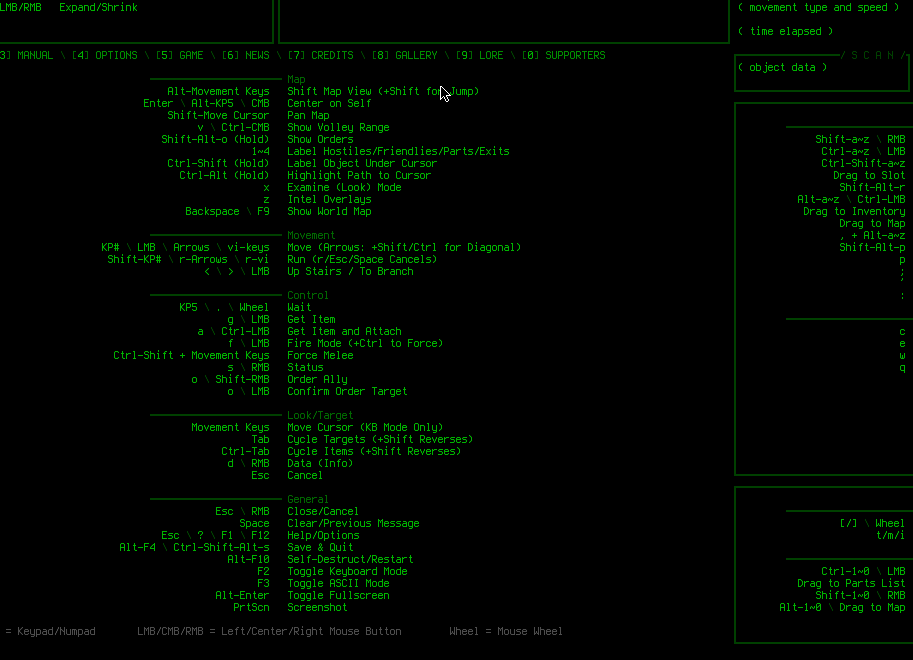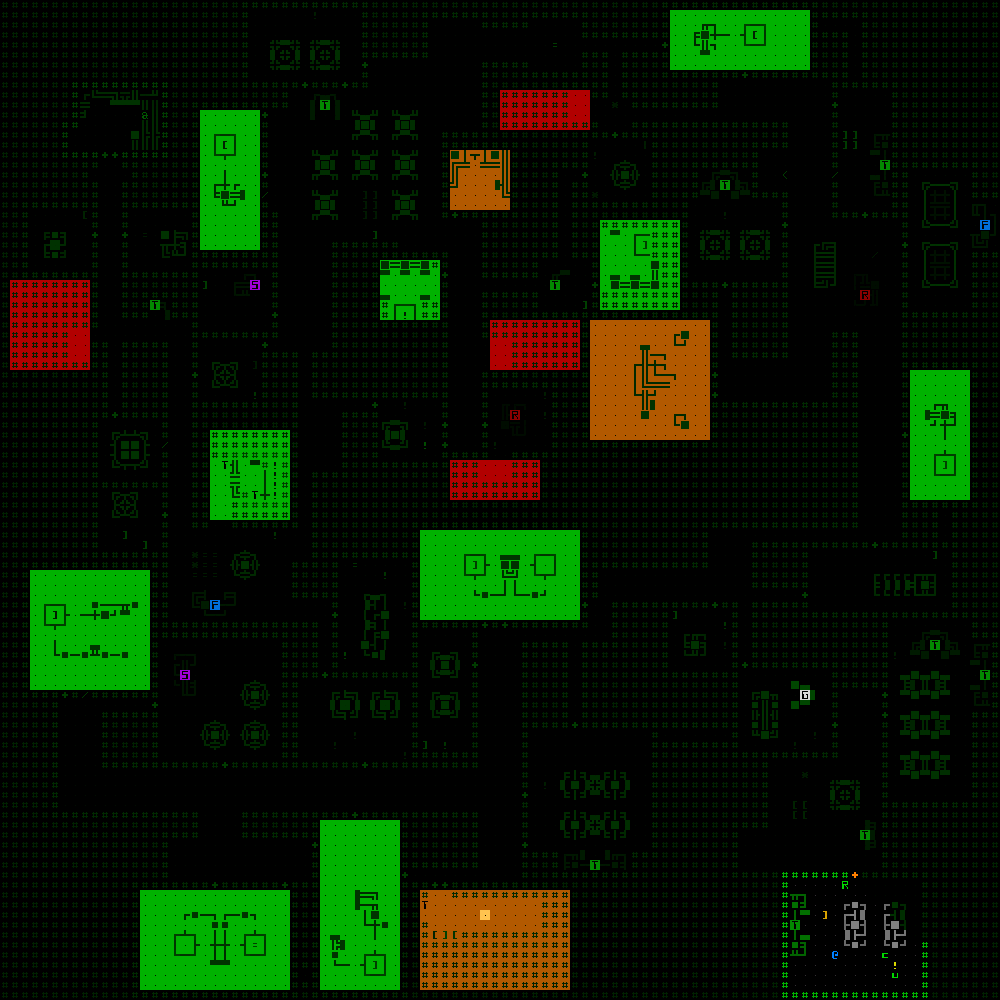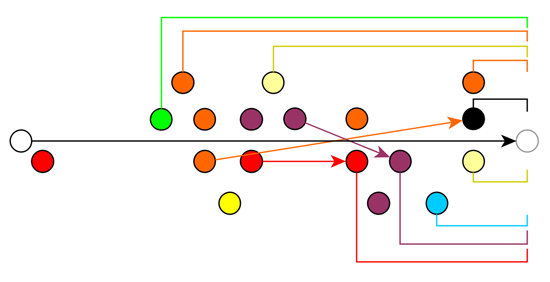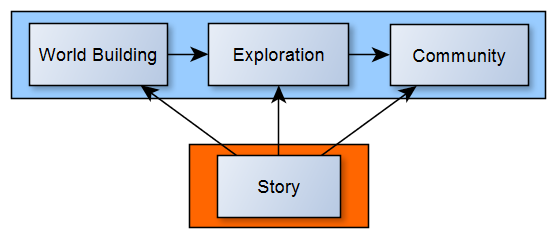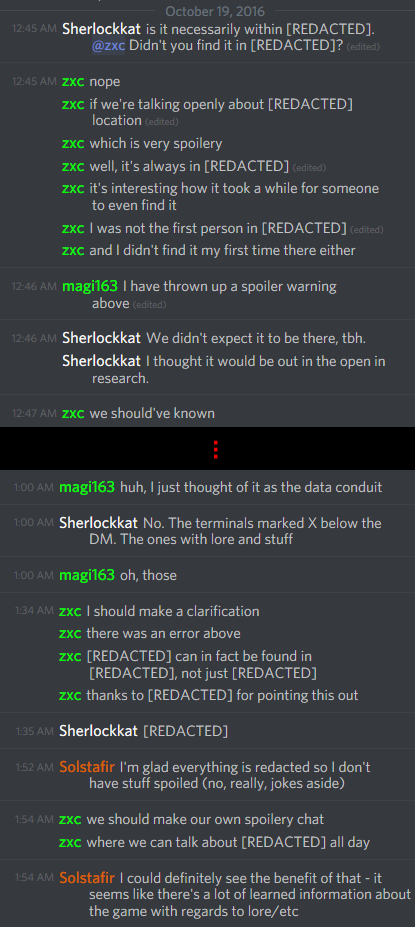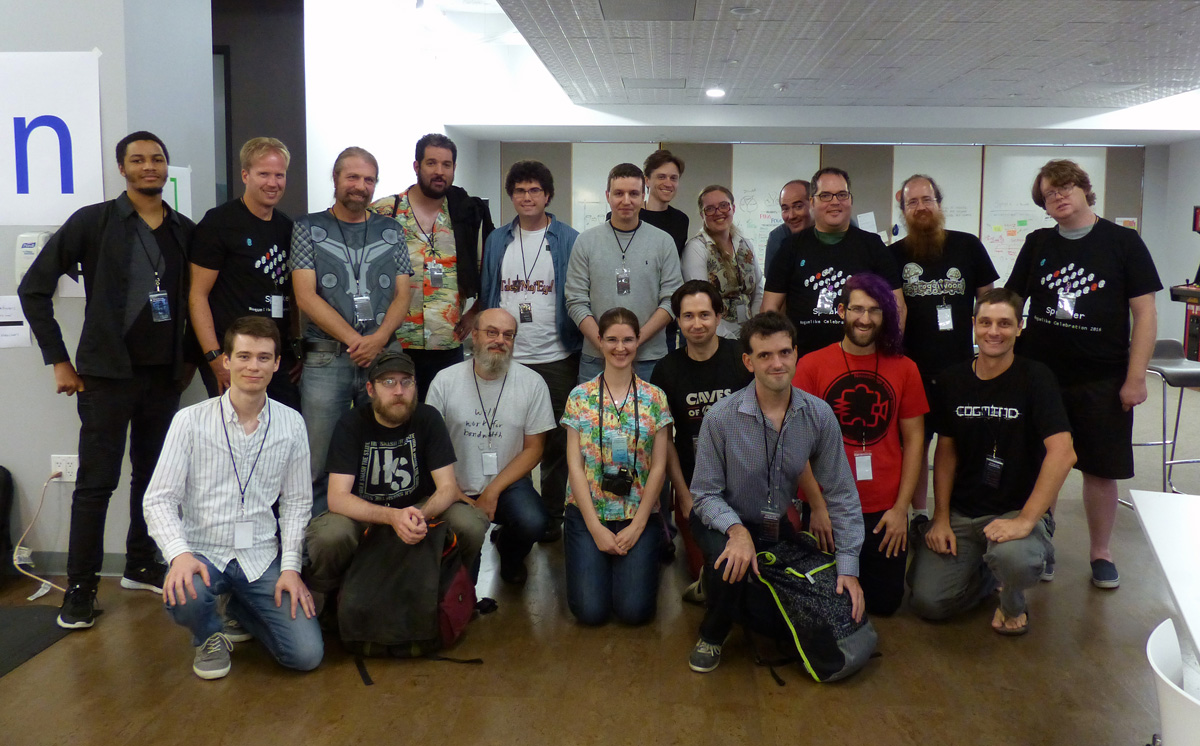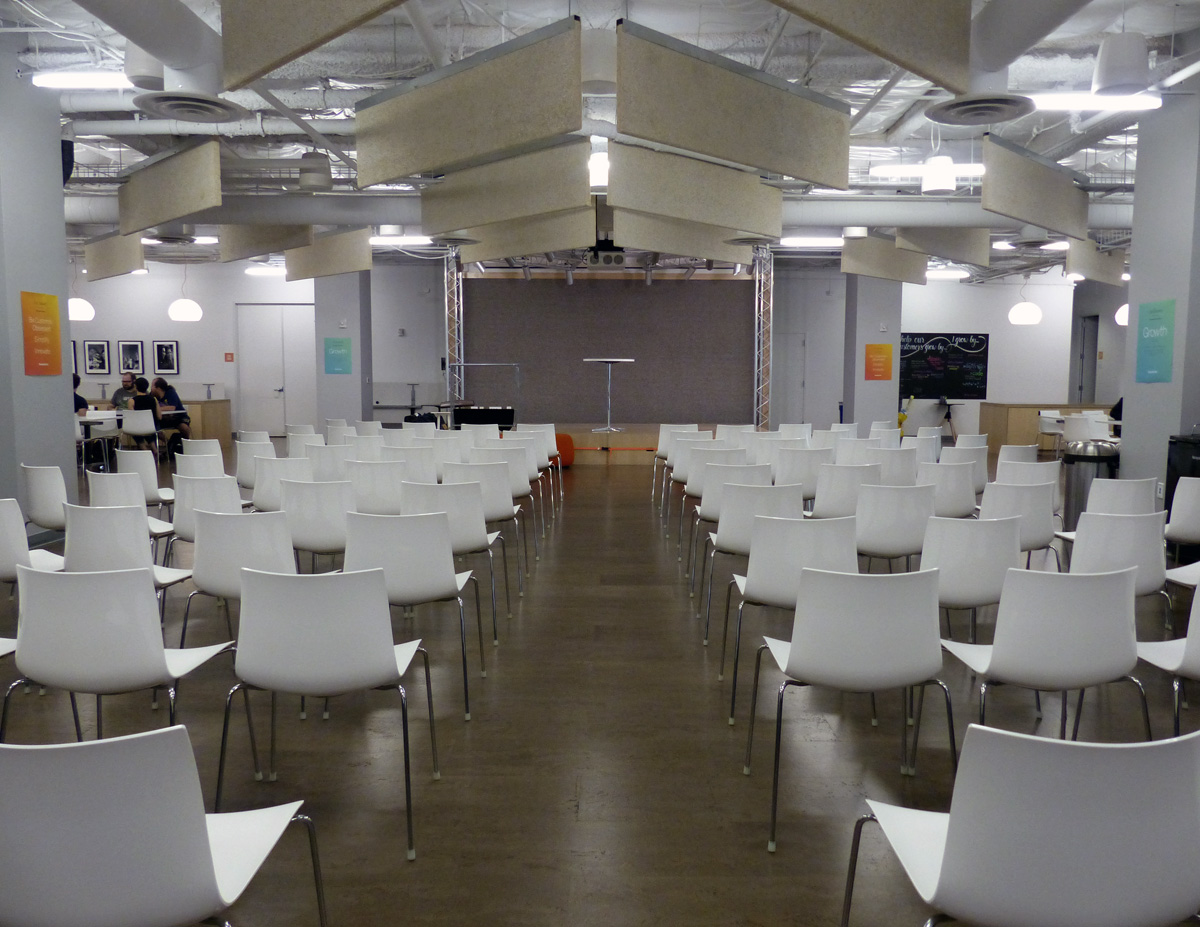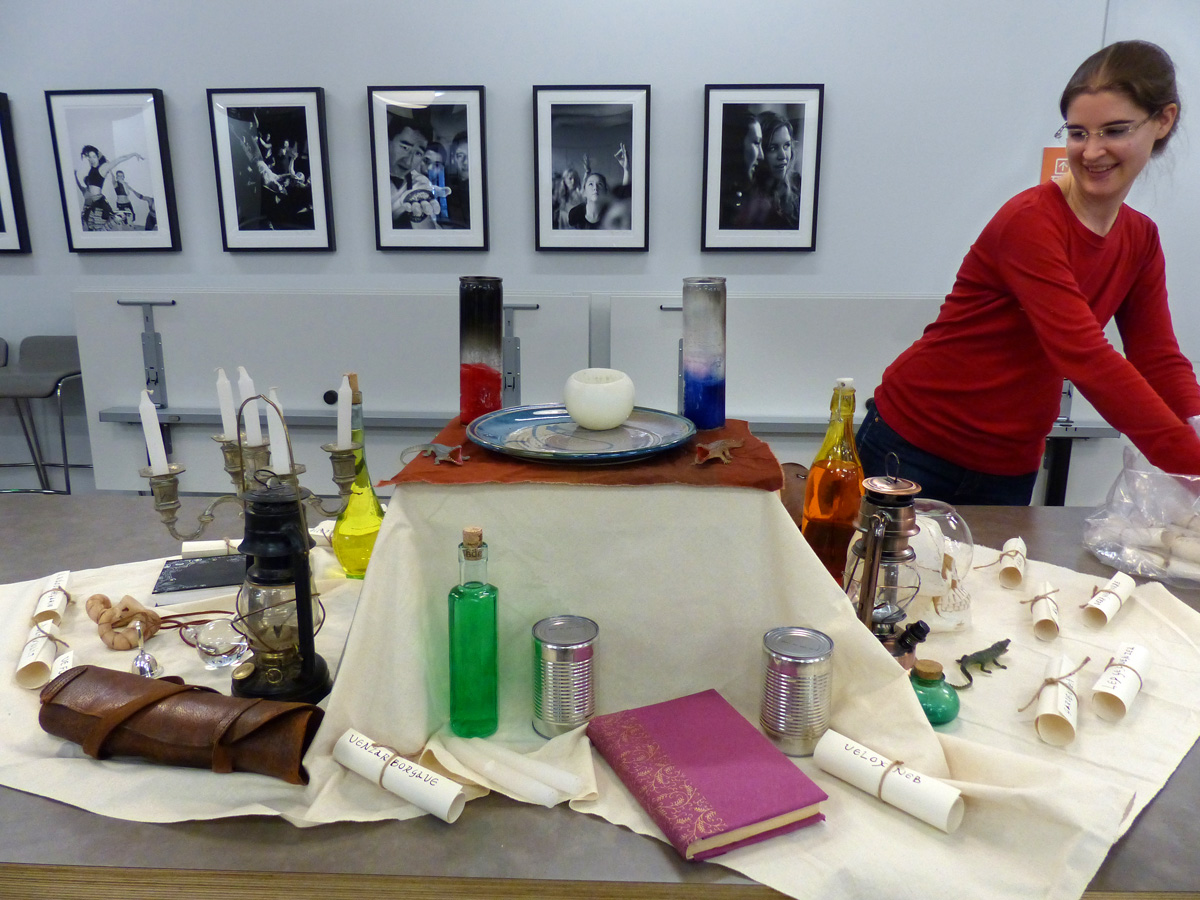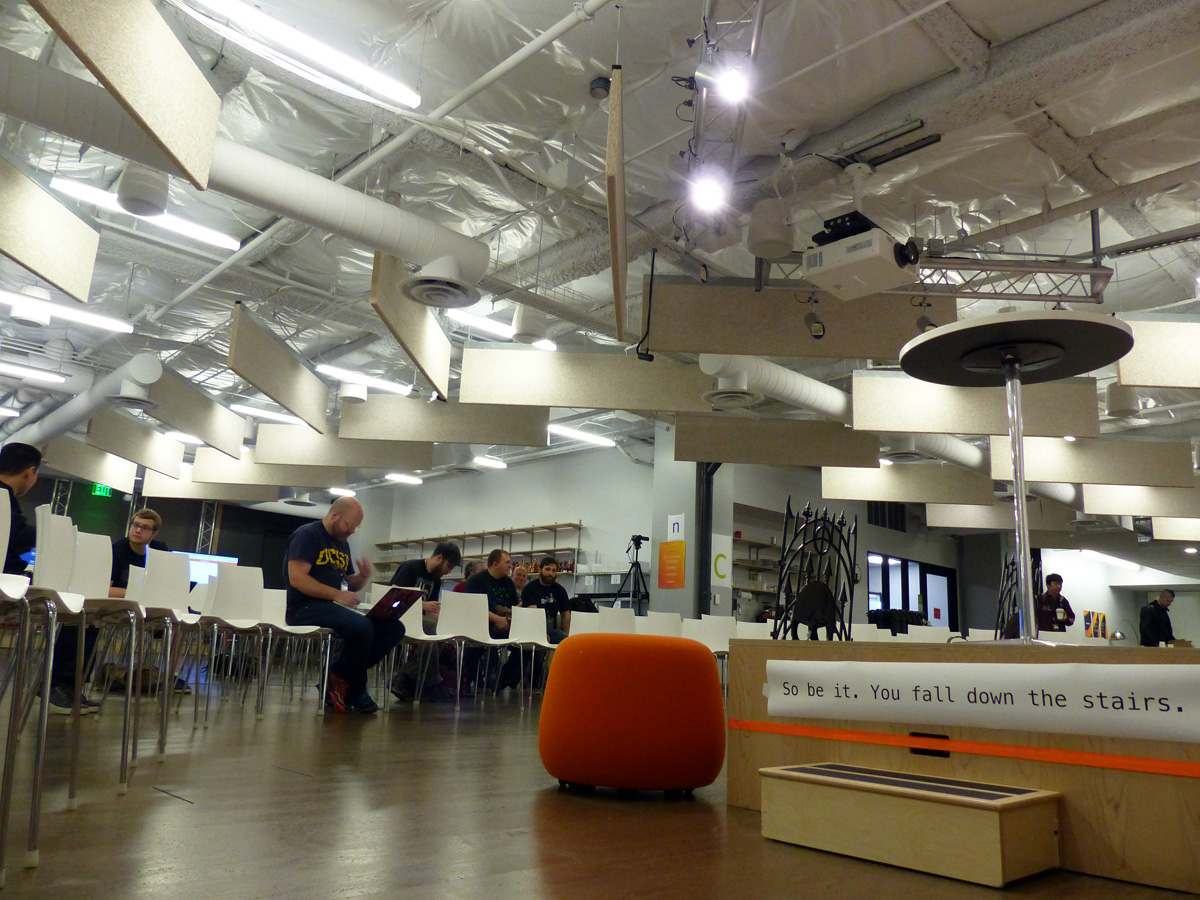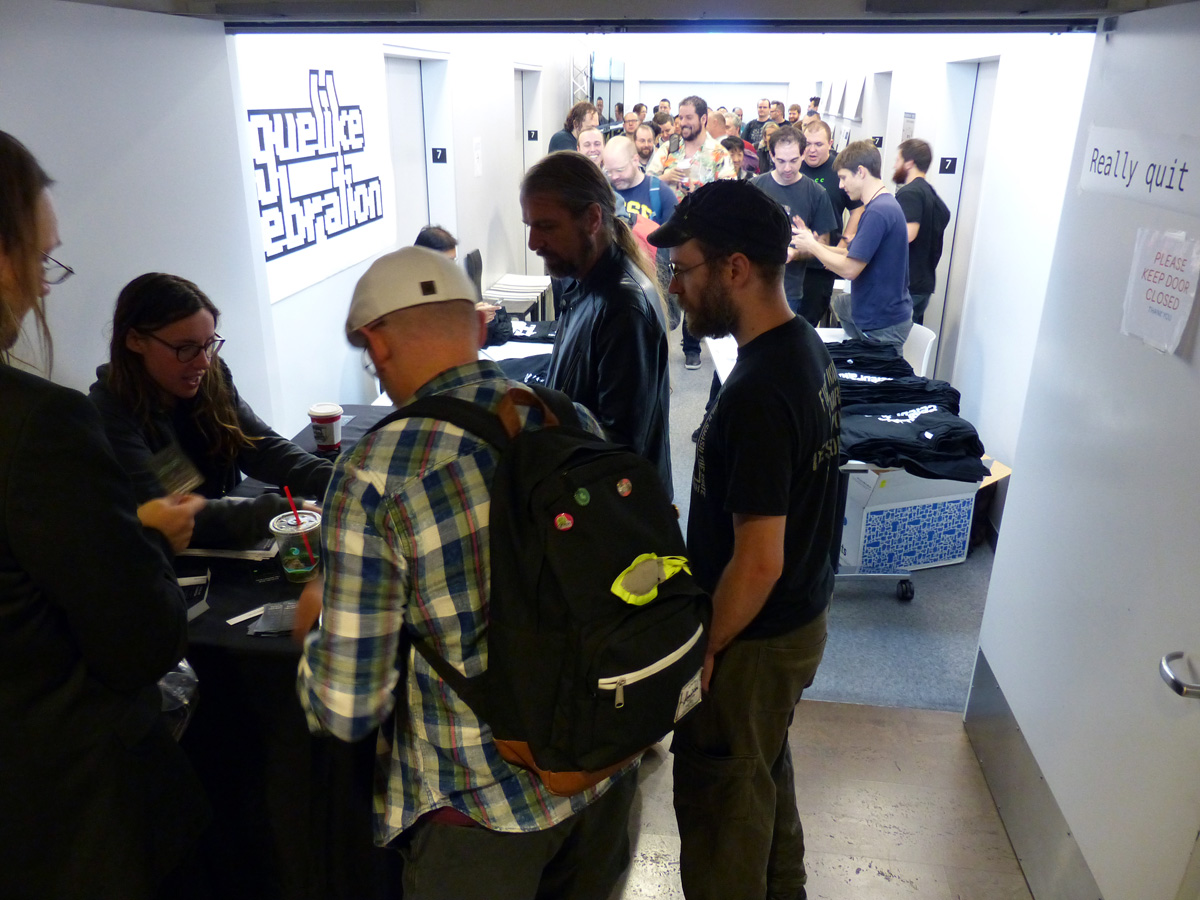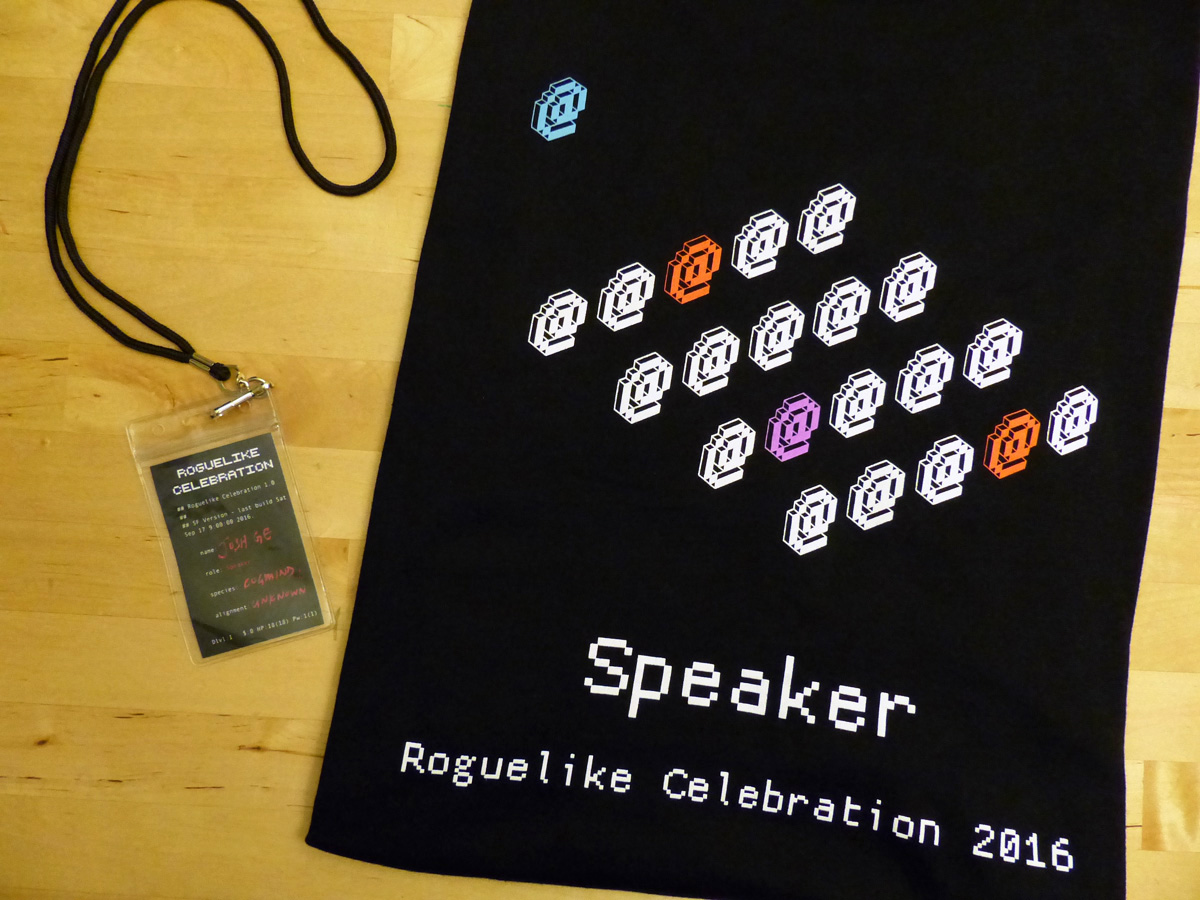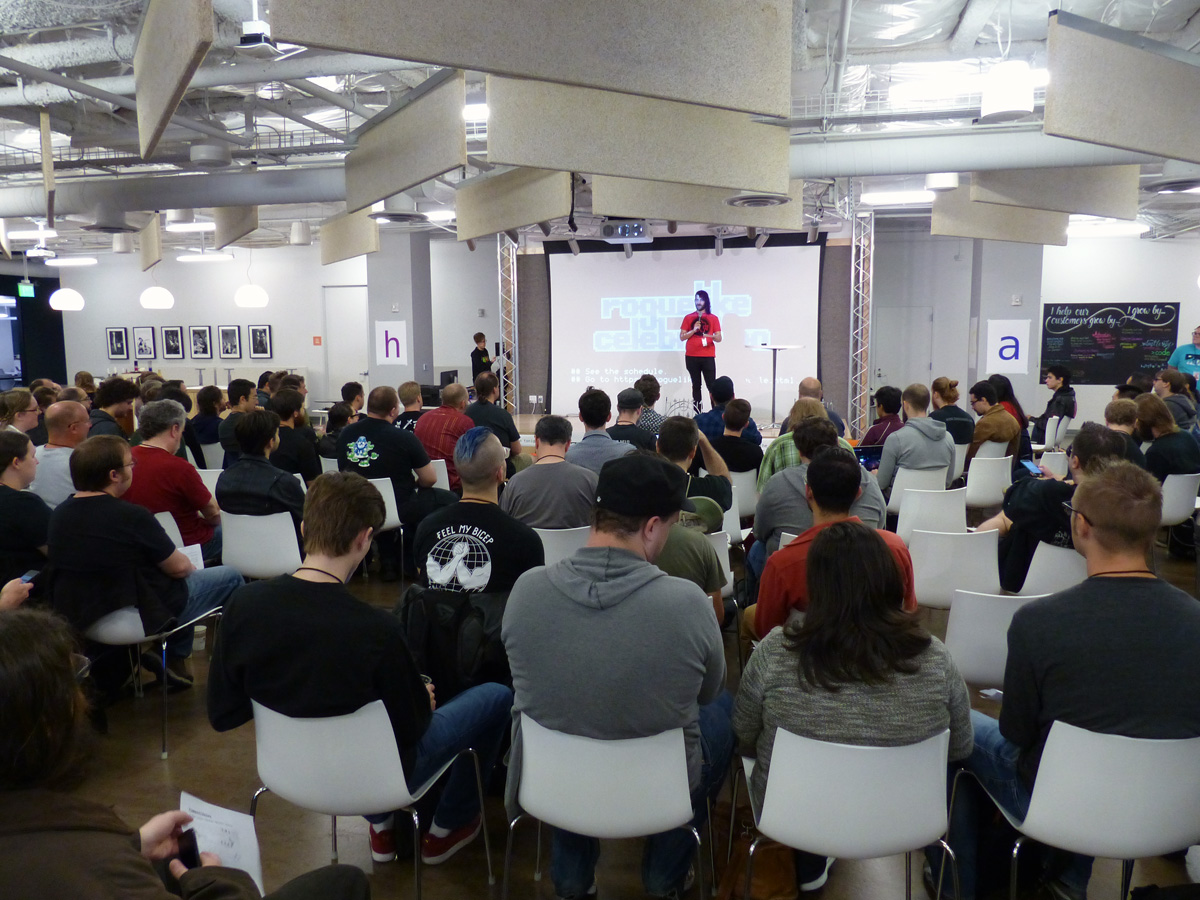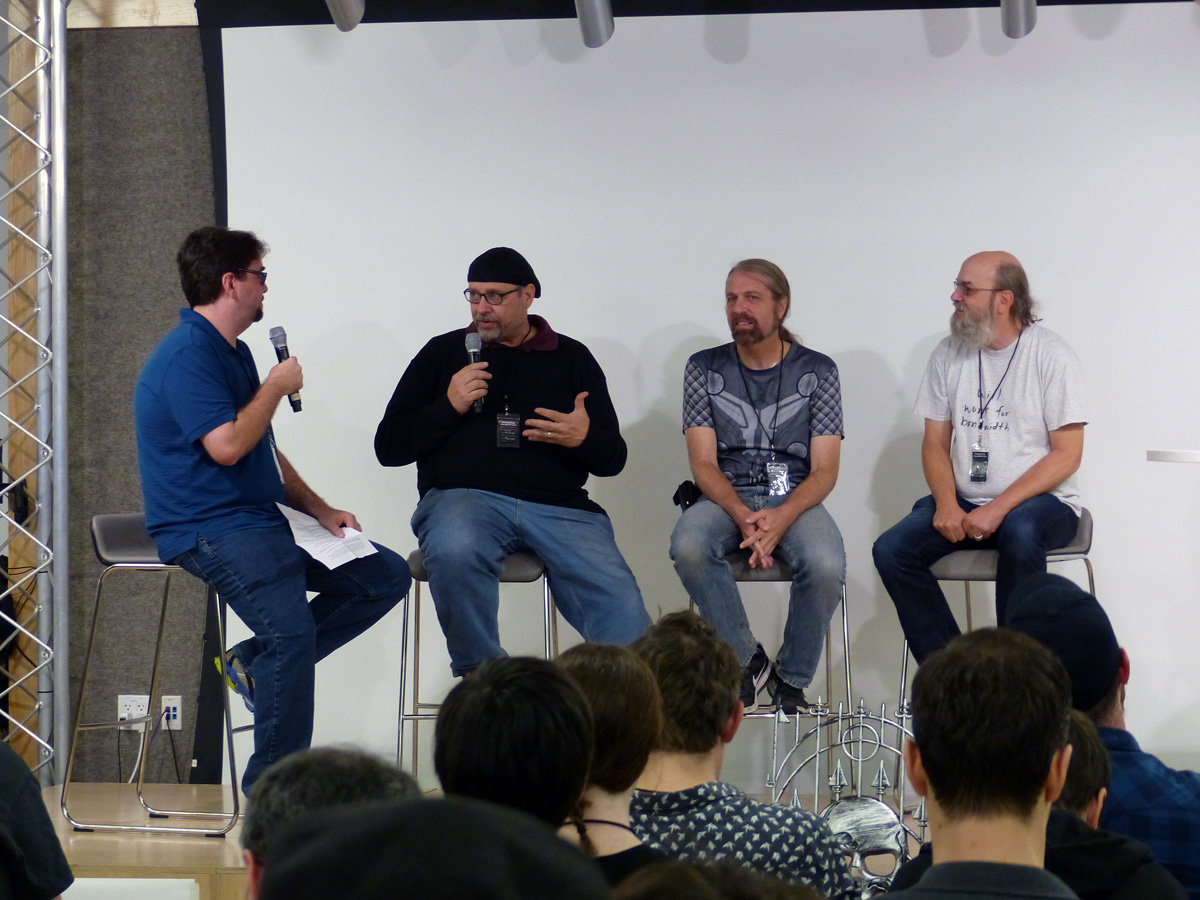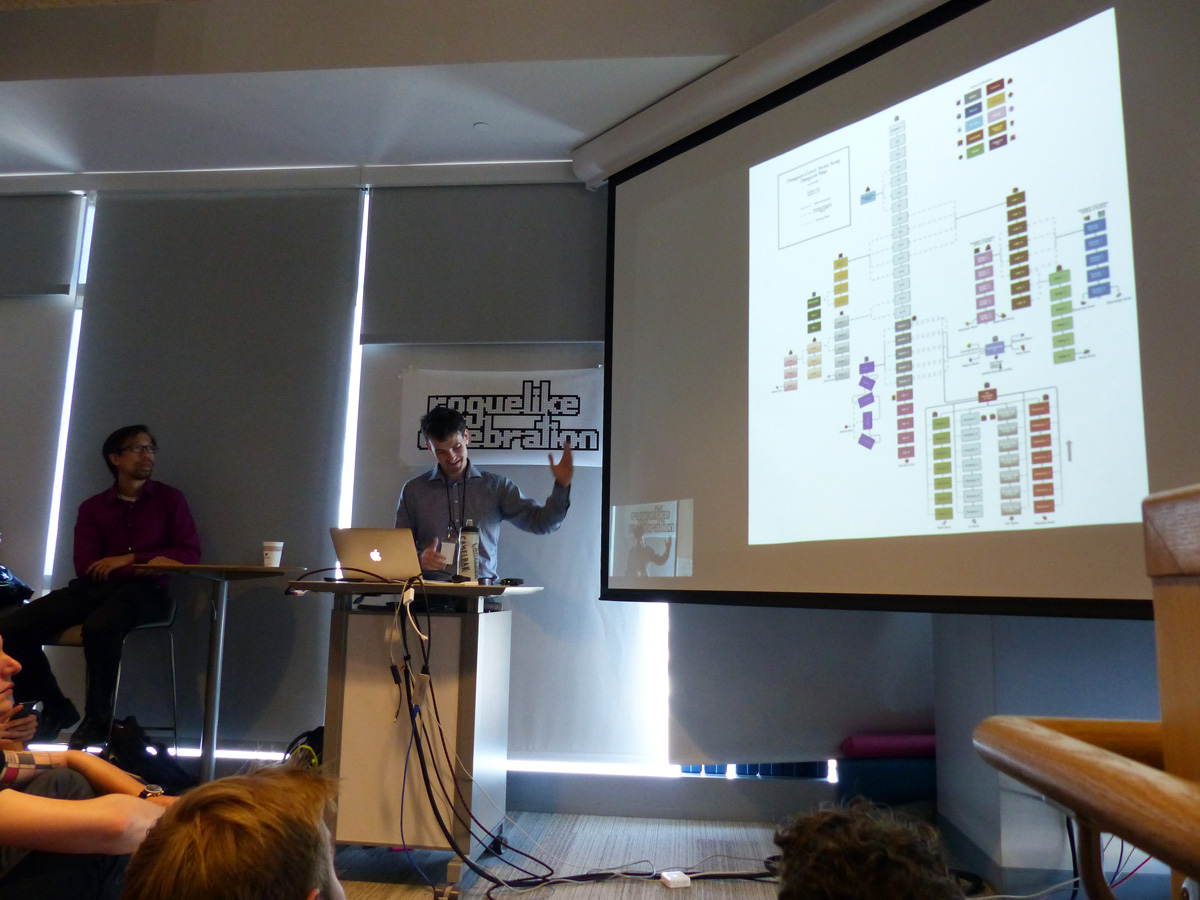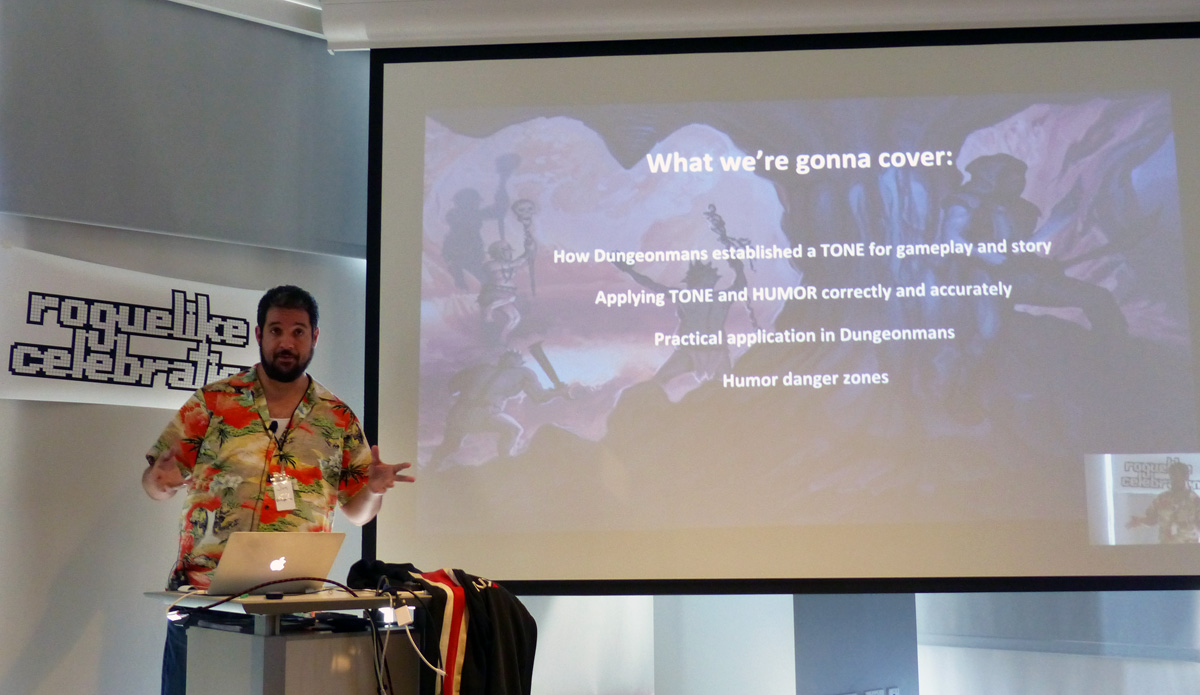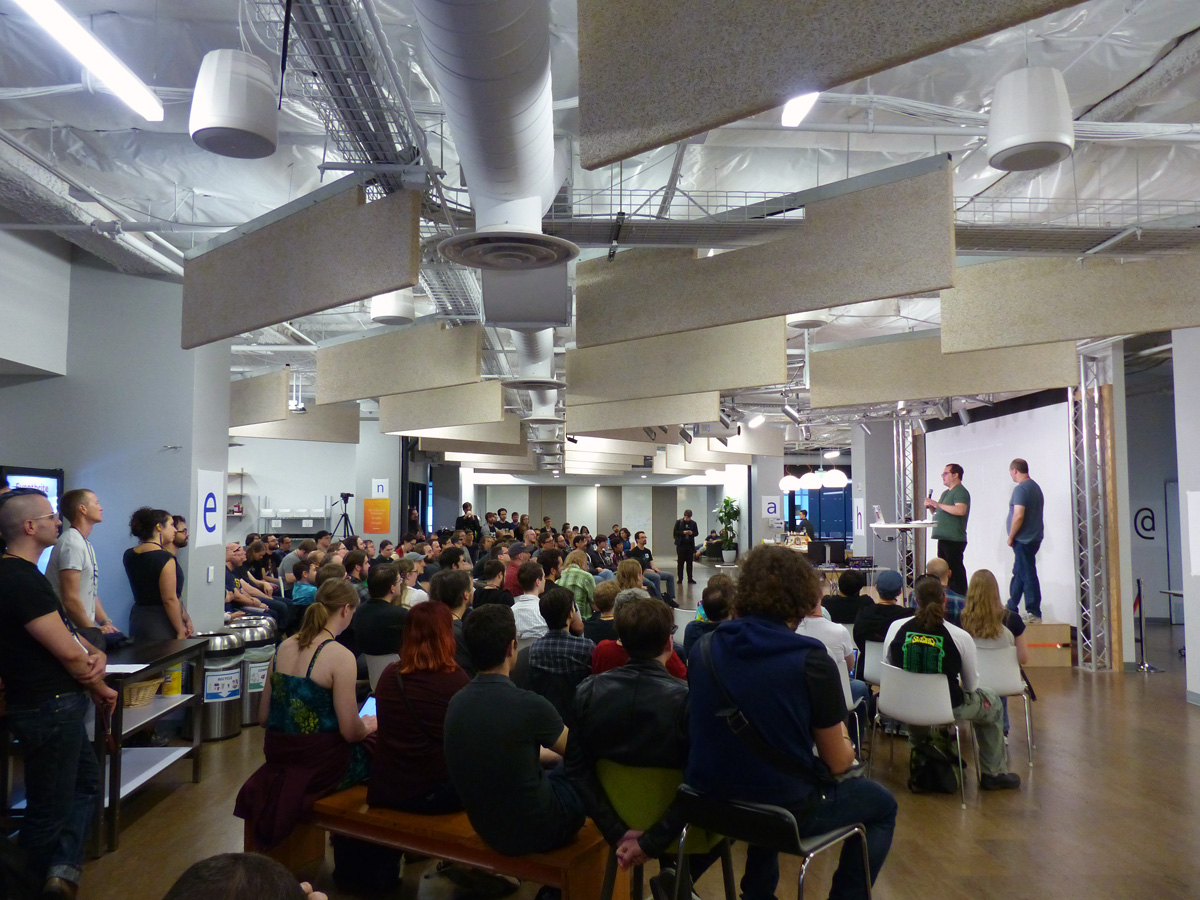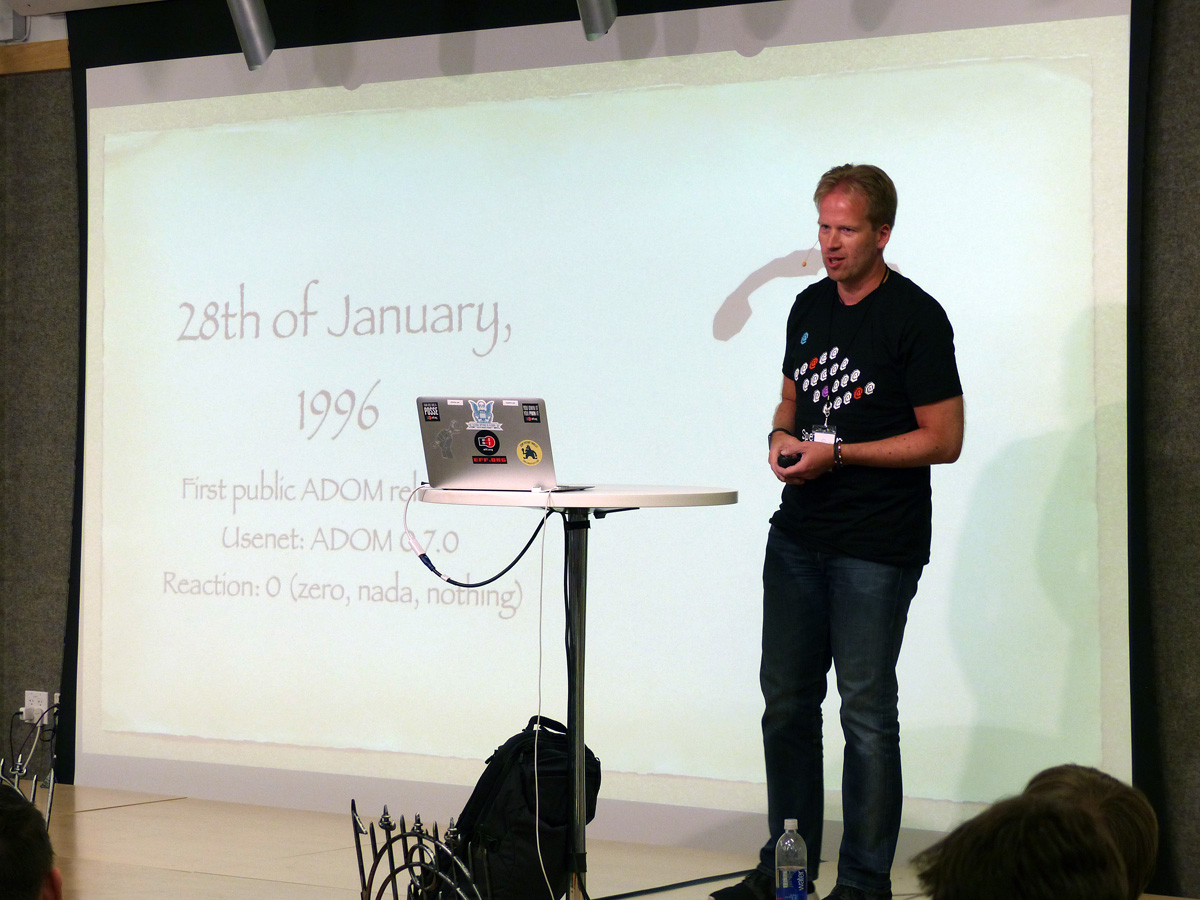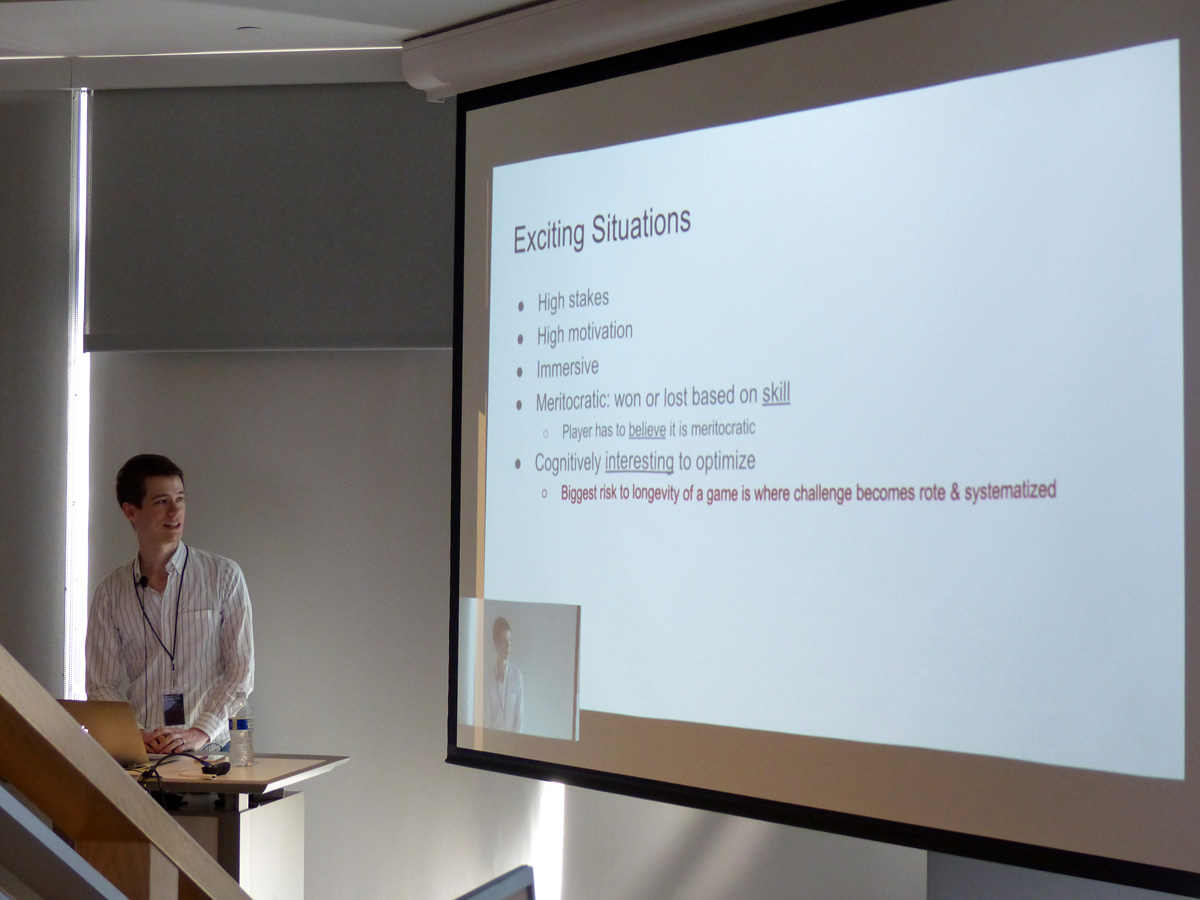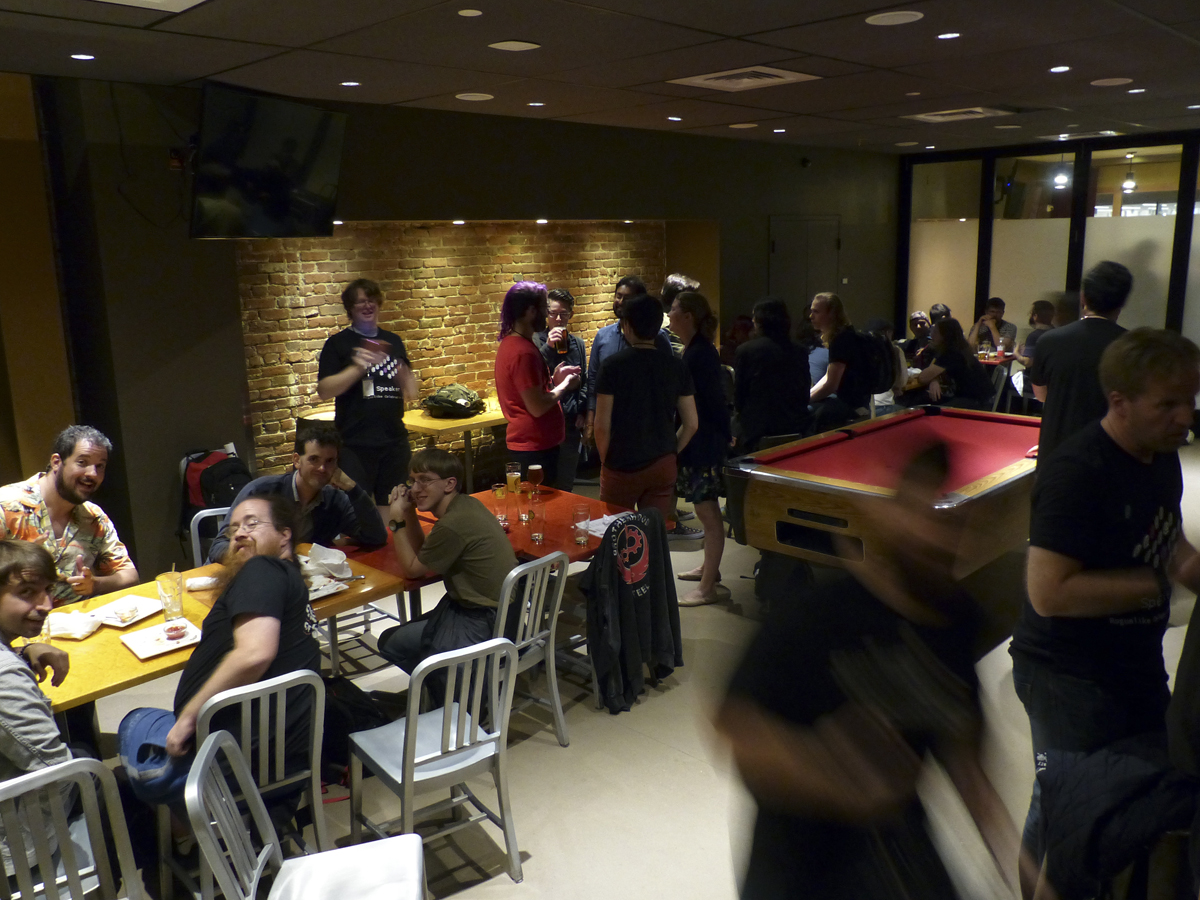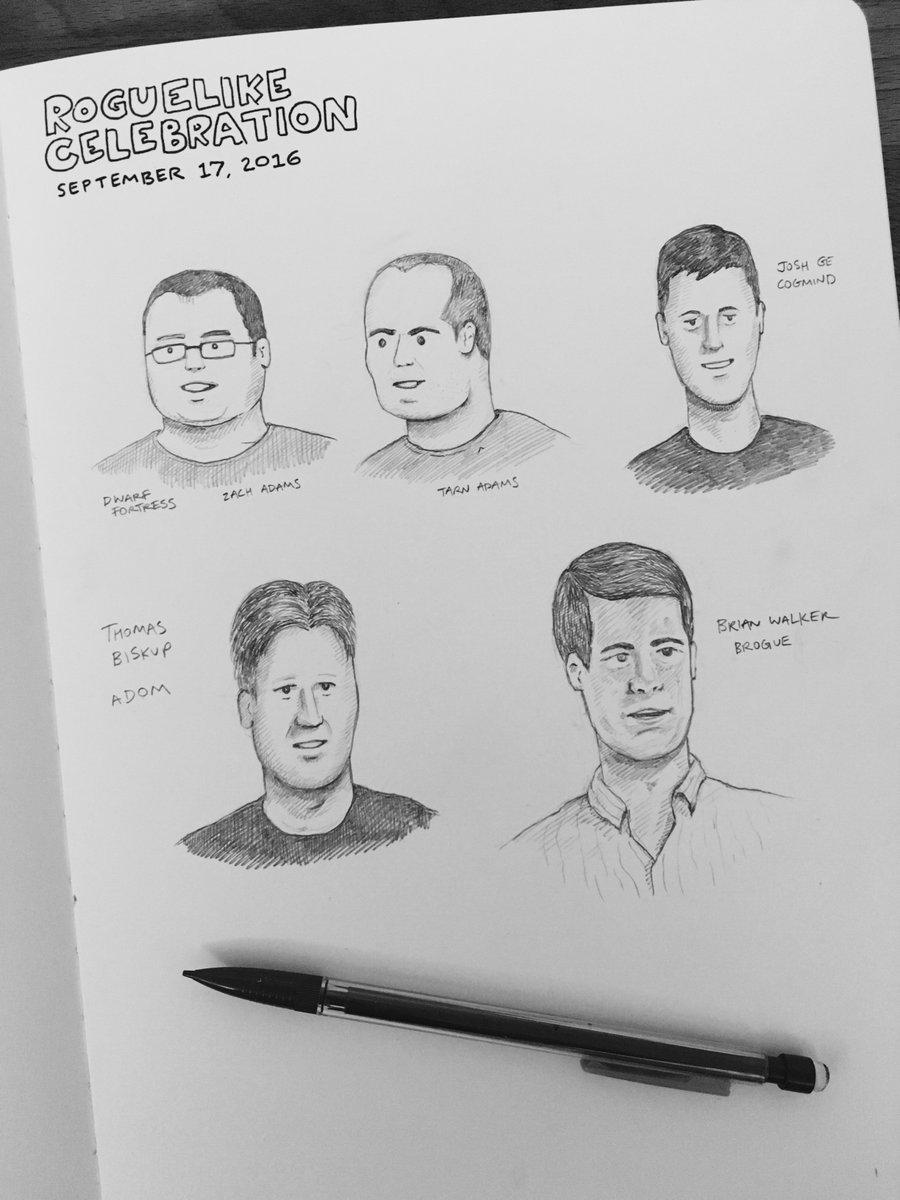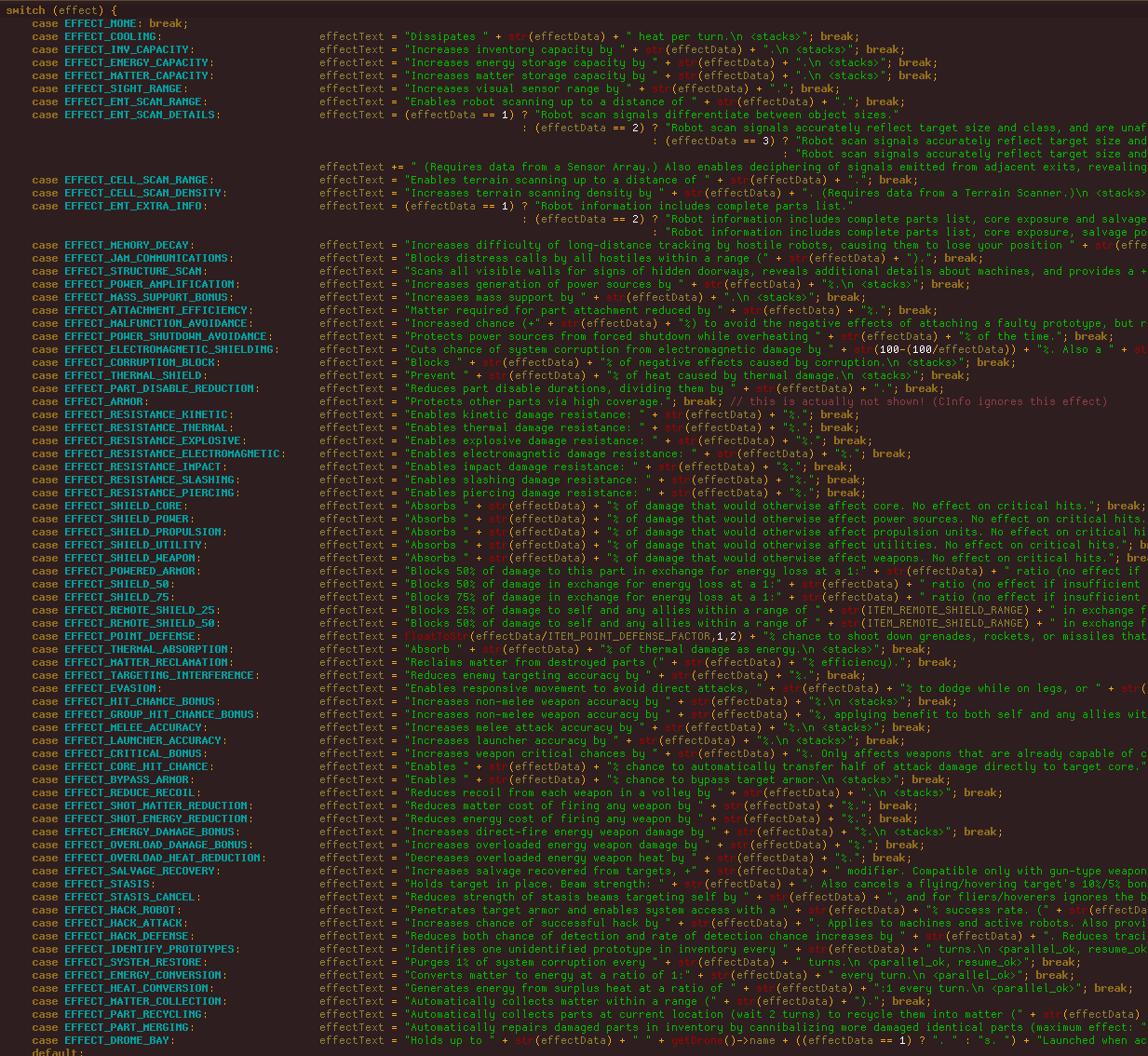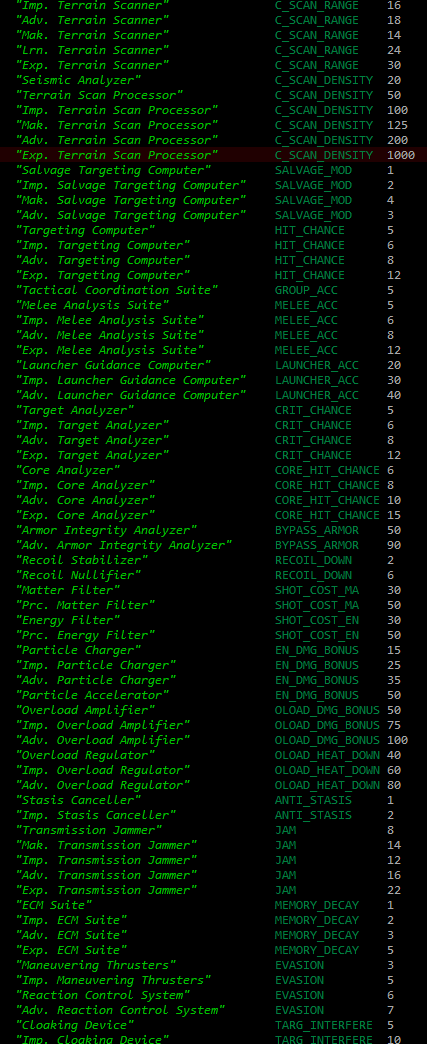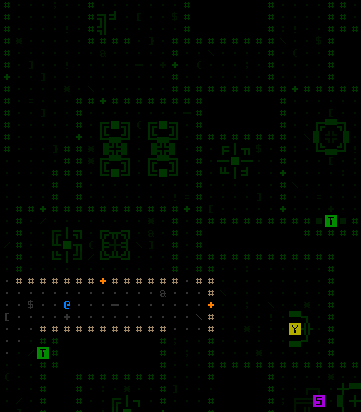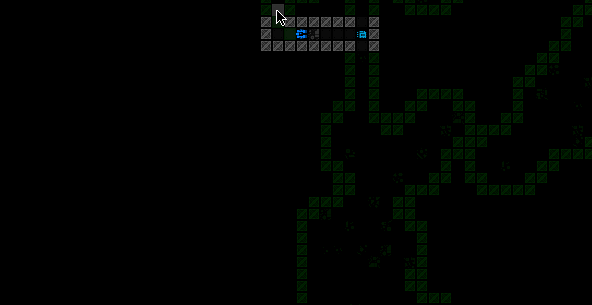With Part 1 (Value) and Part 2 (Characteristics) of this series as a background, it’s time to examine the variety of methods Cogmind uses to achieve those goals, which are important considerations every step of the way. This is also what is meant by “weaving,” because there are quite a few individual components working together to reinforce the narrative, and reflect it.
Structure
When creating a roguelike in which a story can thrive, I believe the most fundamentally important decisions involve the world layout and how the player traverses it. For a non-linear story experience, it makes sense to have multiple available destinations at once, be it presented as some kind of open world, or maps connected in some sort of network. Cogmind uses the latter, dividing the world into areas which belong to either the central complex, or branches linked from there but which eventually lead back to the complex. (I talked about this and several related topics in the World of Robots post last year.)
An important distinction between the two types of areas is that the story is confined to the branches, meaning the player can spend the majority of their time on the direct route to the surface/end and never even come in contact with story. There are no NPCs or dialogue along that route, and before long anyone who wants story will know where to find it.
Branches are structured such that the more story-oriented ones are generally deeper, and there is a quicker way to loop back into the main complex before seeing much, if again the player is not interested (or too weak, since story areas are more challenging!). Overall this structure is key to the “optional” characteristic discussed last time--players aren’t required to engage with the story,
Most players do at some point start to develop an interest in the story, but it happens gradually, which is beneficial as it keeps the world simpler for new players, while opening up new options for more experienced players. In fact, for better players who may still be unaware of the story, the additional strategic options that stem from integrating story elements with gameplay are one of the primary hooks driving them to explore. For example there are the “manual hacking codes” which often link otherwise unrelated areas by having a code obtained in one area provide some kind of benefits in another.
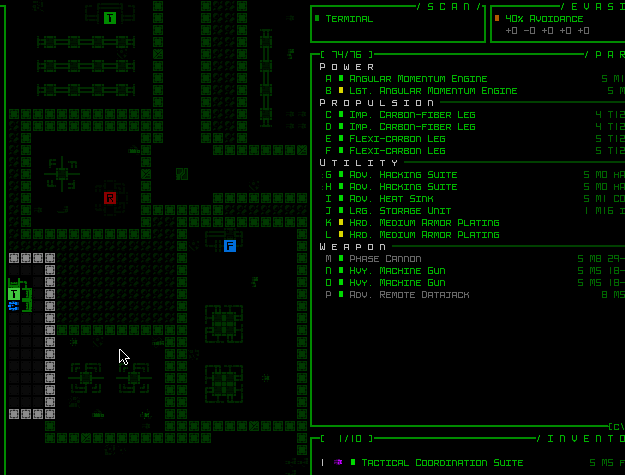
Using the manual hacking code assist feature added in Alpha 10, listing where and who originally provided each code. (Also works for robot hacking.)
That the player cannot backtrack to earlier areas is crucial here. Taking one route naturally closes off one or more others. Cogmind would be quite a different experience if it were open world, or even just possible to return to previous maps!
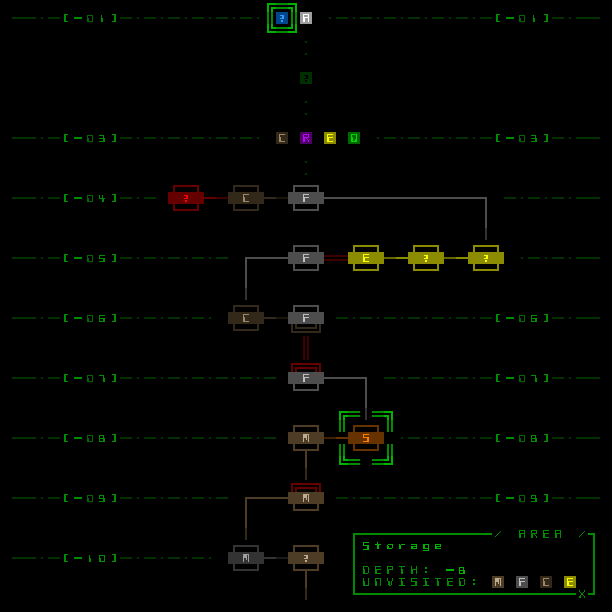
Sample in-game world map tracing the player’s path from deep underground towards the surface.
There is a huge amount of design freedom enabled by forcing the player forward, allowing for greater developer control which in turns makes it easier to maintain a more focused and fun experience. Good balance is important in a roguelike, but so is overall flow (not so much in sandbox roguelikes, where players are responsible for their own flow).
Note that all branches are accessible in every world, though the impossibility of visiting them all in a single run presents the player with interesting choices, choices that continue to expand as they learn more about its structure and get closer to the end.
Lore & Dialogue
There is quite a lot of lore in Cogmind, appearing in various forms to provide multiple different channels for the player to explore the story.
Games will naturally embed their lore, essentially the backbone of the story, wherever appropriate for the theme and setting. e.g. books, tombstones, travelogues, etc. At the extreme there are cRPGs which allow you to read inscriptions and text from just about any object, though traditional roguelike environments are only so rich and a systematic/streamlined approach is more appropriate, suggesting that we limit lore to a handful of easily recognizable sources.
One of Cogmind’s primary gateways to lore are terminal records (definitely not an uncommon practice in sci-fi games :P). Terminals can be hacked for background information on various topics, organized so that the closer to the surface/end, the further into the story those topics are sourced. Most of the records are written from one of the factions’ point of view, while records on terminals found in outlying areas might provide other points of view.
All pieces of lore are not created equal, either. Some are more mundane and generally available, while others are designed to be found in special areas, so uncovering the full set of lore and figuring out the story is somewhat of a puzzle that takes time--many runs (and a good enough player to piece together). The content of records may also link to other records, which can in turn be hacked directly from there, giving the lore a web-like form that always entices the player with yet more topics to explore :)
If players don’t want to hack the terminal records for whatever reason (and it’s easy not to because terminals have so many other useful functions), then the story doesn’t even come into play there.
Lore is also embedded in “robot analysis” records, which provide a real benefit to players who hack them (accuracy and dodge modifiers against that type of foe), but also describe their components and maybe a bit of story-relevant fluff about each robot’s purpose or history.
Probably the lore feature most unexpectedly absent from Cogmind is item descriptions. Even many games without an emphasis on story (or any story at all) might have flavor text for item descriptions, using that to set the tone. In Cogmind this would be a massive amount of work--so many items!--and more importantly I don’t think having that kind of fluff immediately available for items fits the theme. It wouldn’t be able to do the best job an item description could do without muddying the idea that the player is a robot, and not actually playing a robot. There’s also not enough room to display that kind of info without putting it in a separate window :P. (Note, however, that dozens of items do have lore in the form of terminal records, so it’s not non-existent, just not ubiquitous.)
Dialogue
Lore can also be obtained by listening to NPCs, usually by bumping into them, but sometimes by simply coming into visual range. The content is often just fluff and tidbits from different viewpoints to reinforce the lore, as well as the occasional general tip or strategic or tactical suggestion. For those I try to write them in a way that feels like a logical thing the NPC might say (to a stranger or in whatever the given situation/location is), as opposed to an overt “I am NPC #23 and I exist solely to tell you this out-of-context piece of information.”

Sample dialogue text in the message log.
As mentioned earlier all of these NPCs are off the beaten path to the end, but even there they and their dialogue are very unintrusive, simply appearing as text in the message log, and for a short duration at the bottom of the map view.
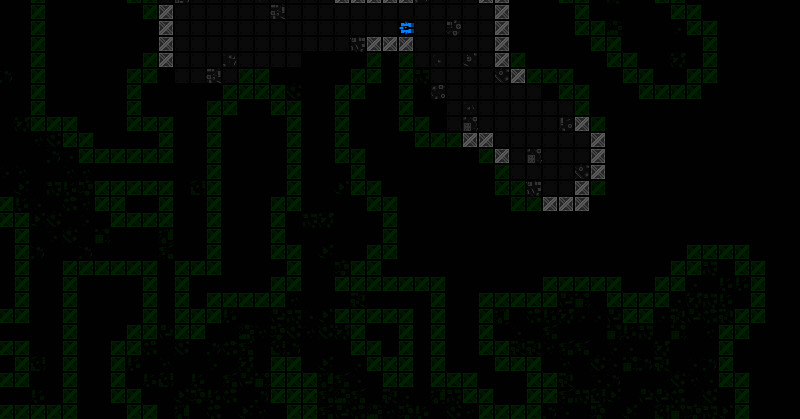
An NPC talking as the player moves around.
Similarly, there are a few examples (it’s an underused system…) whereby a short description of some scene may also pop up at the edge like that.
Slightly more intrusive are the modal dialogue boxes used for major NPCs and encounters in some special areas, though the frequency of those is kept to a minimum. It’s quick and easy for the player to simply hit Escape or close the window for those they’re already familiar with (or not initiate them in the first place).
See this earlier post for more talk about the dialogue UI.
Update 170428: I’ve written a more in-depth look at the uses of dialogue in Cogmind here.
Lore Collection
Now that most of the lore is completed and in game, not too long ago a new and valuable feature was added: the lore collection interface. This is a central repository for all the lore the player has encountered throughout all of their runs, where “lore” includes most NPC conversations and terminal records. The contents are categorized by location and ordered alphabetically, where players can skip to a section by simply pressing the first letter of the entry they’re looking for, or scroll around the list to autoload text.
To facilitate lore collection, terminal records the player has never read before are marked with a ‘!’ directly in the terminals from where they are available. And beyond the reference value of having all this info conveniently in one place, the percent bar there at the bottom reveals some of the system’s other benefits.
Players can know just how much of the information about the world they have or haven’t discovered, which tends to encourage them to learn more about the world, a strong incentive to explore when combined with the (correct) assumption that these unexplored areas likely also contain lots of interesting gameplay possibilities!
Players are now comparing each others’ “percentage of lore collected” (a bit of competition), and more importantly can watch their own meta progress in the new scorehistory.txt which also records the cumulative lore value at the end of each new run. It’s nice to have progress meters aside from score alone.
Encounters
Another aspect of Cogmind that fills out the world with story-related content, albeit in a piecemeal fashion rather than any kind of linear narrative experience, is the encounter system. These “mini-experiences” created with scripts and handcrafted map pieces, sometimes with heavy randomization, again reinforce the lore at various points.
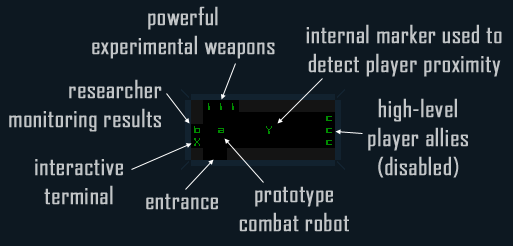
An example prefab encounter as seen in REXPaint, the program I use to “draw” most of Cogmind’s encounters. One faction is testing the effectiveness of their prototype robot and new weaponry, and what better target than a couple of their sworn enemies? (disabled, of course) There are a variety of things that can happen with this single scenario. A quick-thinking (and moving!) player could blast through the southeastern wall, which is likely along a corridor, and rewire the allies through the new entrance to immediately fight back. Or if the player is spotted and reported not far from this room, regardless of the state of the tests, said prototype robot will likely be dispatched in defense. Or the player may want to attack first and later rescue the allies, or do it to loot the room of its experimental weapons. Or ignore the room completely and stay out of trouble :P
Of course some of these experiences are pure fluff, though many have other implications as well. And while handcrafted, when placed near one another, or when players encounter them in various unique situations, emergent results make them somewhat unique each time. That’s the beauty of mixing handcrafted content into procedural generation algorithms--it’s possible to get the best of both worlds :D
I’ve written more about encounters before in articles on Map Composition and Generating and Populating Caves, though I haven’t shown a distribution sample for any corridor-based maps before, so here’s a new image:
Localized environmental storytelling is easy to do like this. For example some scrap and broken down robots from two opposing factions strewn across a cave, or an abandoned partially-destroyed base that might still contain a terminal with bits of info as to what happened. This isn’t commonly done in many roguelikes due to the traditional de-emphasis of terrain and props.
Yet More Elements
There are still other features that work to increase the appeal of story in roguelikes, though these don’t constitute entire systems on their own so I’ll cover them together here at the end.
- Once a game includes NPCs, it’s helpful to include a town of sorts, lore permitting. Cogmind has something like this located in an out-of-the-way area, and it’s a great dumping ground for a lot of those tidbits of lore and knowledge mentioned earlier. Even better, the available dialogue for each run is selected from a larger pool, increasing replayability for a time. I’ve also seen a number of players appreciate the change of pace that such a location brings. Suddenly there’s no fighting, no fleeing, just walking around enjoying the scenery and talking.
- Secrets! Some topic mentioned in passing in one area might have some implication for another area. Or talking to one NPC might trigger some event elsewhere (or a chain of events!). Secrets drive exploration, and lore is a great place to sneak them in rather than in a purely environmental sense (e.g. “what’s behind that door?” or “what if I attack this non-hostile actor…”).
- Multiple endings. Cogmind will have more than one ending, some of which reflect the extra difficulty of different approaches to the story elements, while others are simply different due to choices made. Unique endings reward the player for exploring alternative challenges, and are also an opportunity to tell a little more of the story, too. (Note: Cogmind does not yet include multiple endings--we’re coming up on that soon, though currently a win is already rewarded with a somewhat different ending screen.)
Conclusion
This whole approach to telling a story with a roguelike boils down to the game being “story-backed” rather than necessarily “story-driven.” Revealing the story piecemeal through many different means, where the most interesting parts are the hardest to reach, is a good design to follow since it provides incremental incentives and is more rewarding in the long run. It’s actually easier to win a run of Cogmind than it is to discover the full story, making the latter a potentially even more rewarding experience for some players!
Either way, don’t simply dump the story on the player--that’s the boring method which gets repetitive fast. There are plenty of other options :)
